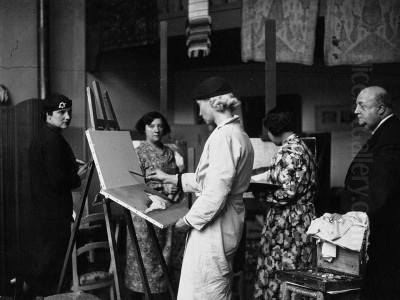
Jean-Émile Laboureur stands as a significant figure in early 20th-century French art, celebrated primarily for his exceptional contributions to printmaking and illustration. Born in Nantes on August 16, 1877, and passing away in Pénestin, Brittany, on June 16, 1943, Laboureur navigated the dynamic artistic currents of his time with remarkable skill and a distinct personal vision. He was a versatile artist, proficient not only as an engraver and etcher but also as a woodcutter, lithographer, illustrator, and watercolorist. His work elegantly bridges traditional craftsmanship with the burgeoning aesthetics of Modernism, most notably Cubism, securing him a unique place in art history.
Early Life and Artistic Formation
Initially destined for a career in law, Laboureur abandoned his legal studies in Paris to pursue his true passion: art. This pivotal decision led him to the Académie Julian, a renowned private art school that fostered many talents of the era. His formal training in printmaking began under the guidance of Auguste-Louis Lepère, a master wood engraver himself, from whom Laboureur learned the intricacies of woodcut techniques. This early focus on woodcut is evident in his initial works, which often show a stylistic affinity with the Post-Impressionist innovations of artists like Paul Gauguin, characterized by bold lines and decorative compositions.
Further expanding his technical repertoire, Laboureur sought instruction from another giant of the Parisian art scene, Henri de Toulouse-Lautrec. Under Lautrec's influence, he delved into the mediums of etching and lithography, absorbing the expressive potential of line and tone inherent in these processes. This period of intense learning laid the foundation for his future mastery across various printmaking disciplines, equipping him with a diverse toolkit to articulate his evolving artistic ideas. His early exposure to influential figures like Lepère and Toulouse-Lautrec provided not just technical skills but also immersion in the vibrant artistic debates of fin-de-siècle Paris.
Travels and Broadening Horizons
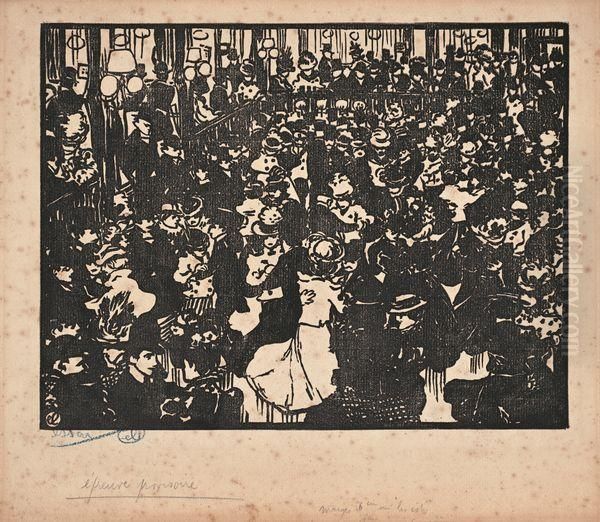
Laboureur's artistic development was significantly shaped by his extensive travels during the late 1890s and early 1900s. He journeyed through Germany, Italy, England, and notably, North America, visiting the United States and Canada between 1904 and 1909. These experiences abroad broadened his perspectives and provided rich subject matter. His time in the United States, for instance, resulted in works like the portfolio Ten Etchings of Pittsburgh (published later, reflecting his 1905 visit), showcasing his keen observation of urban and industrial landscapes, a theme that would recur in his work.
These travels exposed him to different cultures, landscapes, and artistic environments, enriching his visual vocabulary. He absorbed influences ranging from classical art seen in Italy to the bustling modernity of American cities. This period also saw him begin to exhibit his work, gradually building a reputation. His experiences informed his depictions of modern life, adding layers of understanding to his portrayals of different locales and their inhabitants. The ability to capture the essence of a place, whether a European capital or an American industrial hub, became a hallmark of his printmaking.
Embracing Modernism: The Influence of Cubism
Around 1911-1912, Laboureur's style began a noticeable shift towards Modernism, culminating in a distinct engagement with Cubism between 1913 and 1914. While not a core member of the movement's pioneering circles led by Pablo Picasso and Georges Braque, Laboureur absorbed the revolutionary concepts of fragmented forms, multiple viewpoints, and geometric structuring. He translated these ideas into the linear medium of etching with remarkable finesse, creating a series of large-scale etchings that stand as unique contributions to Cubist printmaking.
During this phase, he associated with artists exploring similar directions, including Jacques Villon, Marie Laurencin, André Derain, and Henri Le Fauconnier, figures often linked to the Section d'Or group or the broader Cubist milieu. Laboureur exhibited these Cubist-inspired prints at important avant-garde venues like the Salon des Indépendants and the Salon d’Automne. His works from this period are characterized by angular lines, flattened perspectives, and a sophisticated interplay of planes, yet they often retain a certain elegance and clarity distinct from the more radical deconstructions of Picasso or Braque. He skillfully adapted Cubist principles to his preferred medium, demonstrating the versatility of the style beyond painting.
The War Years and Aftermath
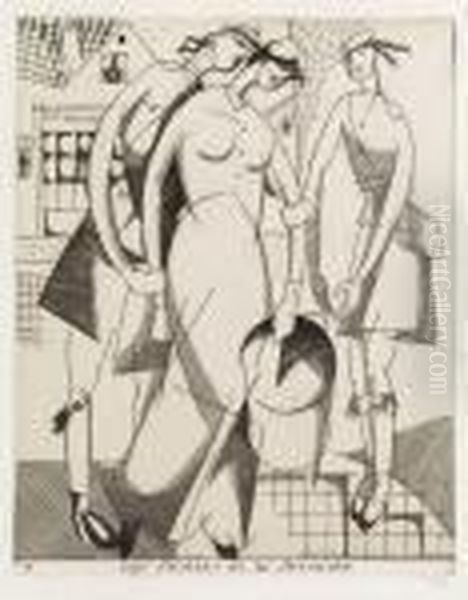
The outbreak of World War I interrupted Laboureur's artistic trajectory, as it did for many artists of his generation. Due to health reasons, he was deemed unfit for direct combat but served the Allied effort as an interpreter, primarily with the British and later the American forces. This wartime experience provided a different kind of subject matter. He documented his observations not through depictions of battle, but rather through sensitive portrayals of daily life near the front lines, capturing soldiers at rest, camp scenes, and the landscapes marked by war.
His series Sketches from the British Front in the War (1917) exemplifies this approach, offering intimate glimpses into the human aspects of the conflict rather than its violence. These works possess a documentary quality yet are rendered with his characteristic refinement of line. The war years solidified his focus on etching and engraving, particularly using the burin, a tool demanding precision and control. Following the war, Laboureur emerged as a mature artist, deeply committed to the art of printmaking during a period that saw a significant revival of interest in original prints in France.
Championing Original Printmaking
In the post-war era, Laboureur became a key figure in the movement to elevate the status of original printmaking (gravure originale). This movement emphasized prints conceived and executed entirely by the artist, distinguishing them from reproductive engravings that merely copied other artworks. Laboureur was a fervent advocate for the intrinsic artistic value of print media. His commitment materialized in 1923 when he co-founded the Société des Peintres-Graveurs Indépendants (Society of Independent Painter-Engravers).
This influential society brought together prominent artists who were dedicated practitioners of printmaking alongside their work in painting. Its membership included major figures such as Raoul Dufy (his close collaborator in founding the society), André Dunoyer de Segonzac, Marie Laurencin, Maurice de Vlaminck, and even Georges Braque for a time. The society organized regular exhibitions, promoting the diversity and quality of contemporary French printmaking. Laboureur's leadership role underscored his dedication to fostering a supportive community for printmakers and educating the public about the medium's artistic significance. He later served as President of the Comité national de la gravure française in 1938, further cementing his role as a leader in the field.
Mastery of Technique and Style
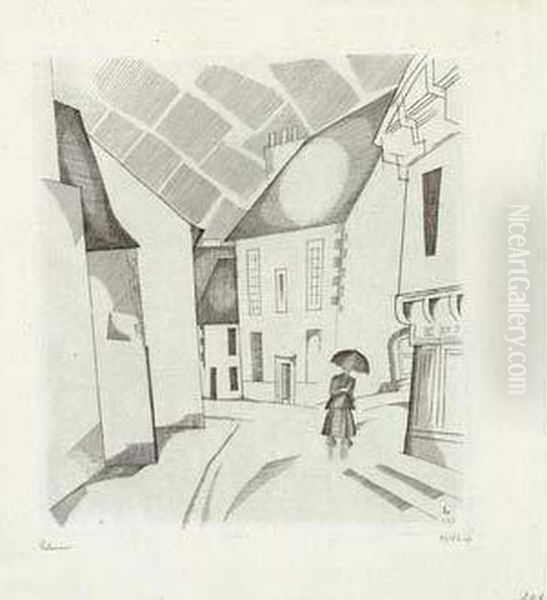
Jean-Émile Laboureur's reputation rests significantly on his exceptional technical proficiency across various printmaking methods. While trained in woodcut, etching, and lithography, he became particularly renowned for his mastery of engraving with the burin and etching. His line work is consistently precise, elegant, and controlled, whether delineating complex urban scenes, capturing the subtleties of a landscape, or rendering the human form. He possessed an innate understanding of how line could create form, texture, and atmosphere.
His style is often described as linear, refined, and possessing a certain decorative quality, sometimes showing a subtle influence from the compositional clarity and flattened perspectives found in Japanese Ukiyo-e prints, an influence shared by many artists of his generation, including Édouard Vuillard and Pierre Bonnard, with whom his work was sometimes associated in terms of modern sensibility. Even when incorporating Cubist elements, Laboureur maintained a sense of order and grace. He skillfully balanced descriptive detail with modernist simplification, creating images that are both informative and aesthetically sophisticated. His command over technique allowed him to tackle a wide range of subjects with confidence and clarity.
Themes and Subjects
Laboureur's oeuvre explores a diverse range of themes, reflecting his keen observation of the world around him. Parisian life was a frequent subject, capturing the city's cafes, streets, parks, and inhabitants with wit and elegance. He depicted the leisure activities of the bourgeoisie, scenes of everyday life, and the changing urban landscape. His travels provided inspiration for numerous landscapes, particularly the coastal scenes of Brittany, where he spent considerable time later in life. These works often convey a strong sense of place and atmosphere.
He was also interested in the natural world, producing prints featuring animals, plants, and insects, such as his notable etching L'Entomologiste (1935). Portraiture also features in his work. Furthermore, Laboureur subtly addressed the impact of modernity and industrialization, sometimes depicting factories or modes of transport, observing the transformations of society without overt commentary but with a clear eye. His subjects are typically rendered with a blend of realism and stylistic refinement, avoiding overt sentimentality while capturing the character of his chosen scenes.
A Prolific Illustrator
Beyond his independent prints, Laboureur achieved significant recognition as a book illustrator. He brought his distinctive style and technical skill to the illustration of numerous literary works, collaborating with prominent authors and publishers of his time. His illustrations are not mere decorations but thoughtful interpretations that complement and enhance the text, executed with the same care and artistry as his individual prints. His linear precision and compositional clarity were particularly well-suited to the format of the book.
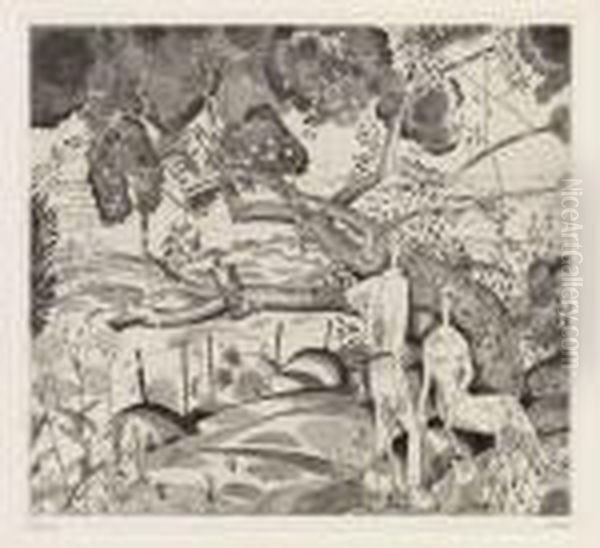
His most celebrated work in this field is arguably the set of 66 engraved illustrations for Roger Allard's novel L'Appartement des jeunesses (1919), considered a masterpiece of modern French book illustration. He also created illustrations for works by esteemed writers such as André Gide, Jean Giraudoux, Colette, Paul Valéry, Guy de Maupassant, and Marcel Proust, among others. This aspect of his career highlights his ability to engage with literature and translate narrative and mood into visual form, making him one of the most sought-after illustrators of the interwar period. His contributions significantly enriched the tradition of the French livre d'artiste (artist's book).
Representative Works: A Closer Look
Several works stand out in Laboureur's extensive output. The illustrations for L'Appartement des jeunesses (1919) showcase his mature style, combining elegant lines with subtle geometric simplification to depict contemporary Parisian life. His Cubist phase is well represented by etchings like Le Bal Bullier or Café du Rond-Point (c. 1913-14), where figures and space are fragmented and reconstructed with linear precision.
From his wartime period, Petites Images de la Guerre sur le Front Britannique (1917) offers poignant vignettes of life behind the lines. Later works demonstrate his continued refinement. Orage (Storm, 1922) and Les pluies en orage (Rain in a Storm, 1923) capture atmospheric weather effects with dynamic line work. Le vieux poirier (The Old Pear Tree, 1925) is a sensitive landscape study. L'Entomologiste (1935) reveals his interest in nature and meticulous detail. The mythological subject Andromède (Andromeda, 1936) displays his flair for decorative composition and bold design. These examples illustrate the breadth of his subject matter and the consistent quality of his execution across different phases of his career.
Recognition and Later Career
Throughout his career, Laboureur enjoyed considerable recognition both in France and internationally, particularly in the United Kingdom and the United States, where his prints found an appreciative market. He exhibited regularly in Paris salons and galleries, as well as abroad. His involvement in organizing exhibitions, such as those for the Société des Peintres-Graveurs Indépendants, and his participation in major events like the 1937 Paris International Exposition (where he held official roles), solidified his standing in the art world.
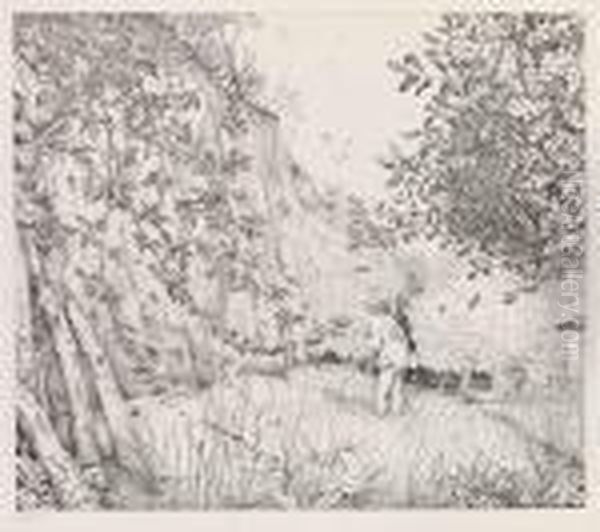
His works were acquired by major public collections during his lifetime and continue to be held by prestigious institutions worldwide, including the Metropolitan Museum of Art in New York, the Museum of Modern Art (MoMA), the British Museum in London, and the Bibliothèque Nationale and the Musée d'Art Moderne in Paris. Despite the disruptions of World War II towards the end of his life, he continued to work, leaving behind a substantial body of prints, drawings, and illustrations. His family, particularly his son Sylvain Laboureur, later played a crucial role in documenting his work through the publication of a multi-volume catalogue raisonné, ensuring his artistic contributions are comprehensively recorded.
Legacy and Art Historical Significance
Jean-Émile Laboureur's legacy lies in his mastery of printmaking techniques, his unique stylistic synthesis of traditional elegance and modernist innovation, and his significant role in the revival and promotion of original printmaking in the 20th century. He demonstrated that printmaking was not merely a reproductive craft but a vital medium for original artistic expression, capable of engaging with contemporary aesthetic concerns like Cubism. His precise and refined linear style influenced subsequent generations of printmakers and illustrators.
He occupies a distinct position in art history as an artist who successfully navigated the transition from 19th-century traditions to 20th-century modernism without sacrificing technical excellence or his personal artistic voice. His work is valued for its aesthetic quality, its technical brilliance, and its insightful depiction of his era. Artists like Félix Vallotton, another master printmaker exploring modern life, or contemporaries involved in the print revival like Dufy and Segonzac, provide context for his achievements. Laboureur remains a key figure for understanding the evolution of French printmaking and illustration in the modern period.
Conclusion
Jean-Émile Laboureur was a remarkably gifted and productive artist whose contributions significantly enriched the landscape of 20th-century French art. As a master printmaker, he navigated the currents of modernism, notably Cubism, while retaining a distinctive elegance and technical precision rooted in traditional craftsmanship. His work as an illustrator brought sophistication and artistry to the printed page, collaborating with leading writers of his day. Through his art and his advocacy, particularly the co-founding of the Société des Peintres-Graveurs Indépendants, he championed the status of original printmaking. Laboureur's legacy endures through his vast body of work, admired for its refined style, technical mastery, and insightful portrayal of the times.